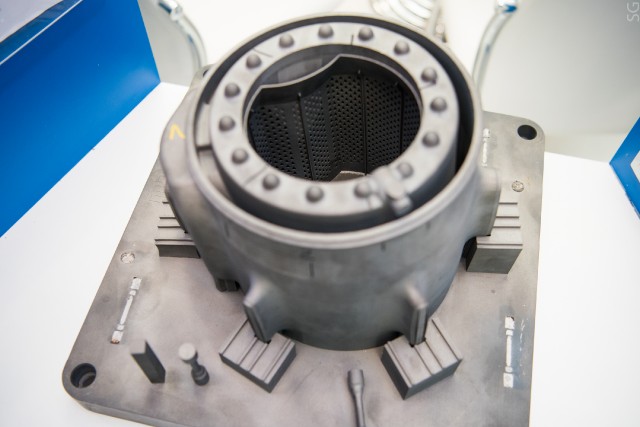
Motor housing
The use of additive technologies in the production of modern aircraft engines allows to reduce the production cycle, reduce production costs and significantly accelerate and optimize the processes of modeling and designing new units.
The scientific and technical team of engineers of SPbGMTU and materials scientists of NUST “MISiS” is engaged in the creation of large-sized units for the domestic aircraft industry. In August 2019, at the MAKS international air show, the first full-size prototype of the promising domestic aircraft engine PD-14 was introduced using direct laser growing technology. By the way, we wrote about this here.
When creating the internal housing of the VK-2500 helicopter engine, the additive technology of layer-by-layer laser fusion (SLM) was used - a large functional part of complex geometric shape was completely "printed" from titanium alloy powder.
We remind you that SLM technology is a 3D printing method in which a metal powder is melted by a laser beam. First, create a 3D model of the product. Then it is divided into 2D layers, which are printed sequentially one on top of the other. A thin layer of powder is applied to a special platform, then the laser fuses the 2D model along the contours, the platform lowers, a new layer of powder arrives, and the cycle continues.
“The presented functional node is really unique. We can say with confidence that this is the first detail of such complexity and such size obtained in Russia using the technology of layer-by-layer laser fusion from domestic powder materials, ”deputy. Evgeny Zemlyakov, Director for Research and Design Activities, Institute of Laser and Welding Technologies, SPbGMTU.
The use of the SLM method in combination with the optimization of 3D-printer modes dramatically reduced the amount of subsequent machining of the motor housing (grinding, turning, etching, etc.), respectively, the production time was reduced from more than 30 to 14 days. This allows you to reduce the production cost of the node, thereby ensuring the overall competitiveness of the domestic aircraft engine.
“Together with colleagues from NUST“ MISiS ”we are implementing a comprehensive project in which the most interesting additive technologies are developed from the point of view of industrial application. This is direct laser growing and layer-by-layer laser fusion (SLM technology). Each technology has its own field of application. Direct cultivation is used by us for the manufacture of blanks with dimensions from 0.5 m to 2 m. Layered laser synthesis - for blanks up to 0.4 m in size, ”says Evgeny Zemlyakov. - Both methods are complex multi-factorial processes that require an integrated approach. In SLM technology, this is modifying a part for additive technology, determining the orientation of a part during the growing process, choosing growth strategies and designing supporting structures. Moreover, manufacturing technology is not limited only to the operation of a 3D printer. ”

Engine housing - how it looks from the inside
As one of the developers of the project, the director of the EcoTech Institute of NUST “MISiS” Andrey Travyanov notes:
“A massive part“ grows ”in the production process layer by layer, and at a certain moment, with a set of masses and when creating surface curvatures, the workpiece geometry begins to“ float ”. Result - the part is rejected. With this in mind, in modeling and subsequent cultivation, many - up to 75% of the total mass of the part - structural supports are used that grow parallel to the part and must be removed after work. We managed to reduce their weight by more than 3 times, from 75% to 23%. "
Such optimization significantly reduced the amount of titanium powder used in the production. At present, tests are being prepared for the resulting engine assembly on the basis of one of the leading specialized engine-building enterprises in Russia.
Recently presented at the stand of the Ministry of Science and Higher Education of the Russian Federation at the Open Innovations forum in Skolkovo.